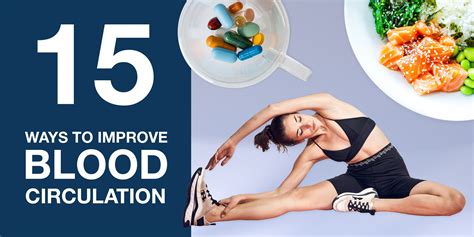How to Boost Blood Circulation Naturally: Improve Your Health Today
Poor blood circulation can lead to a variety of health problems, from fatigue and cold hands and feet to more serious conditions. Fortunately, there are many things you can do to improve your blood flow naturally and enhance your overall well-being. This guide will explore effective strategies to boost your blood circulation and feel healthier than ever before.
Understanding Blood Circulation and Its Importance
Before diving into solutions, it's crucial to understand what blood circulation is and why it's so vital. Blood circulation is the continuous movement of blood through the body's blood vessels, delivering oxygen and nutrients to tissues and organs while removing waste products like carbon dioxide. Good blood circulation is essential for:
- Optimal organ function: Every organ relies on a consistent supply of oxygen-rich blood to function properly.
- Energy levels: Poor circulation can lead to fatigue and low energy.
- Healthy skin: Good blood flow contributes to healthy, radiant skin.
- Wound healing: Efficient circulation is crucial for repairing damaged tissues.
- Reduced risk of chronic diseases: Improving circulation can help mitigate the risk of conditions like heart disease and stroke.
Effective Ways to Boost Blood Circulation
Now, let's explore practical steps you can take to improve your blood circulation:
1. Regular Exercise: The Foundation of Good Circulation
Physical activity is perhaps the most effective way to boost blood circulation. Even moderate exercise significantly improves blood flow. Aim for at least 30 minutes of moderate-intensity exercise most days of the week. Consider activities like:
- Brisk walking: A simple yet highly effective way to get your blood flowing.
- Swimming: Excellent for cardiovascular health and overall circulation.
- Cycling: A low-impact exercise that's gentle on the joints.
- Yoga and Pilates: Improve flexibility and blood flow.
2. Maintain a Healthy Diet: Fueling Your Circulatory System
What you eat directly impacts your circulation. Focus on a diet rich in:
- Fruits and vegetables: Packed with antioxidants and vitamins that support healthy blood vessels.
- Whole grains: Provide fiber, which helps regulate cholesterol levels.
- Lean protein: Essential for building and repairing tissues.
- Healthy fats: Omega-3 fatty acids, found in fish and flaxseed, are beneficial for heart health and circulation.
- Limit processed foods, saturated fats, and trans fats: These can contribute to clogged arteries and impaired circulation.
3. Stay Hydrated: The Life Blood of Circulation
Dehydration thickens your blood, making it harder for your heart to pump effectively. Drink plenty of water throughout the day to maintain optimal blood viscosity.
4. Manage Stress Levels: Stress and Circulation
Chronic stress constricts blood vessels, hindering circulation. Practice stress-reducing techniques such as:
- Deep breathing exercises: Help calm the nervous system and improve blood flow.
- Meditation: Reduces stress hormones and promotes relaxation.
- Yoga and Tai Chi: Combine physical activity with mindfulness.
5. Quit Smoking: A Major Circulation Culprit
Smoking severely damages blood vessels and increases the risk of blood clots. Quitting smoking is one of the best things you can do for your circulatory health.
6. Elevate Your Legs: Simple yet Effective
Elevating your legs above your heart for 15-20 minutes daily can improve blood flow to your lower extremities. This is especially beneficial for those experiencing leg swelling or poor circulation in their legs and feet.
7. Consider Compression Socks: Support for Circulation
Compression socks gently squeeze your legs, aiding venous return and reducing swelling. They can be particularly helpful for individuals with varicose veins or those who spend long periods standing or sitting.
When to See a Doctor
While these lifestyle changes can significantly improve blood circulation, it's essential to consult a doctor if you experience:
- Severe leg pain or swelling
- Chest pain
- Shortness of breath
- Numbness or tingling in your extremities
These could indicate underlying medical conditions requiring professional attention.
Conclusion: Take Charge of Your Circulation
Improving blood circulation is a journey, not a destination. By incorporating these strategies into your daily life, you can significantly enhance your circulatory health, boost your energy levels, and improve your overall well-being. Remember consistency is key, and even small changes can make a big difference over time. Prioritize your health, and your body will thank you.
